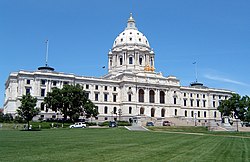Sessions
The legislature met in a regular session from January 3, 1995, to May 22, 1995. A special session convened from May 23, 1995, to May 25, 1995, to consider funding for K-12 schools and other unfinished business. [1]
A continuation of the regular session was held between January 16, 1996, and April 3, 1996. [1]
This page is based on this
Wikipedia article Text is available under the
CC BY-SA 4.0 license; additional terms may apply.
Images, videos and audio are available under their respective licenses.
